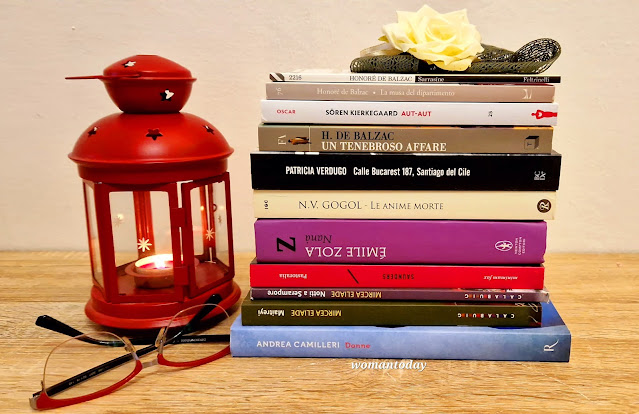Carissimi amici e
lettori,
Oggi recensirò un
nuovo romanzo del famoso scrittore giapponese HARUKI MURAKAMI. In passato avevo
recensito A sud del confine, a ovest del sole e Kafka sulla spiaggia e stavolta
recensirò Norwegian Wood, un romanzo scritto fra il 21 dicembre 1986 e 27 marzo
1987 mentre lo scrittore si trovava in viaggio da Mykonos, Grecia a Roma,
Italia, con un salto intermezzo in Sicilia.
Come prima
impressione, devo informarvi che questo è stato il romanzo che mi è piaciuto di
più fra i tre romanzi che ho letto di questo autore. I tratti inconfondibili
della narrazione di Murakami sono ben presenti, l’erotismo, le descrizioni
precise e molto grafiche, la ricerca del proprio io, il tormento interiore ma,
a differenza di Kafka sulla spiaggia per esempio, l’aspetto onirico è solo
accennato mentre il lavoro nel costruire, illustrare e trasmettere i tratti
caratteristici dei diversi personaggi è molto più marcato rispetto agli altri
romanzi. Ho apprezzato moltissimo questi ultimi due aspetti e sono stata
contenta a scoprire la capacità di caratterizzazione di Murakami soprattutto nel
redigere quattro personaggi femminili tanto diversi, interessanti, emozionanti
e specifici. Ovviamente, il personaggio principale (come anche negli altri
romanzi di Murakami che ho letto) è un giovane maschio, Toru Watanabe e
nonostante il lavoro nel costruire questo personaggio sia stato notevole, di
grande importanza è anche il lavoro nel disegnare i due interessi romantici di
Watanabe, la giovane Naoko, una ragazza bellissima ma insicura, affetta da
psicosi e depressione che aveva perso il suo primo amore e Midori, una ragazza
diretta, decisa, un po’ maschiaccio, ma anche molto sensuale che davanti alle
prove durissime che il destino ha seminato nella sua traiettoria, sviluppa una
corazza di cinismo e nevrosi. Altrettanto bene vengono ritratte anche Hatsumi,
la ragazza del suo miglior amico al collegio e Reiki, una grande amica di Naoko
alla clinica di assistenza e igiene mentale. Mentre i personaggi maschili,
Kizuki, il miglior amico di Toru prima che arrivasse al collegio, Nagasawa, il
suo amico e mentore in rapporti sessuali al collegio e Storm Trooper il suo
compagno di stanza, vengono descritti solo attraverso i rapporti con il
personaggio principale, i personaggi femminili vengono descritti anche tramite
i loro rapporti con membri della famiglia, amici o da loro stessi. I personaggi
maschili hanno principalmente una dimensione dinamica, tutti tranne Watanabe,
lui, come personaggio principale, insieme ai personaggi femminili, ha anche una
dimensione riflessiva, meditativa, provata.
La trama di
questo romanzo riguarda i rapporti amorosi fra coppie di giovani e inizia con
Watanabe l’amico della coppia Kizuki – Naoko, Midori amica di un Watanabe
innamorato di Naoko, Watanabe amico della coppia Nagasawa – Hatsumi, e Reiko,
amica della coppia Watanabe – Naoko. La dinamica di questi triangoli amorosi è
singolare ed è la forza motrice di questo romanzo in quanto tutti gli altri
personaggi vengono presentati solo in base ai rapporti con i membri di questi
triangoli. Nonostante questo, Norwegian Wood, non è un romanzo d’amore ma un romanzo
di formazione in quanto riguarda l’evoluzione di Toru Watanabe verso la
maturità e l’età adulta. Ogni personaggio con cui entra in contatto lo
arricchisce, lo aiuta a scoprire lati di se stesso che fino ad allora non
conosceva o di cui non era consapevole. Ogni sofferenza, ogni godimento lascia
un segno indelebile di cui il nostro personaggio farà tesoro. Più di una volta,
l’autore ha paragonato Toru, attraverso le voci degli altri personaggi, al
giovane Holden, paragone non destinato ad equiparare il lavoro di un giovane
Murakami al leggendario anche se meno famoso, Jerome David Salinger, ma, a
facilitare la comprensione del personaggio Watanabe grazie ai riferimenti alla
cultura di massa riguardanti il giovane Holden Caufield.
Rispetto agli
altri romanzi scritti da Haruki Murakami che ho letto fino ad adesso, Norwegian
Wood ha un finale meno eclittico e più ottimista nonostante la solita caratteristica
di indefinito. Murakami non è uno dei miei scrittori preferiti ma questo
romanzo mi ha fatto riconsiderare certi aspetti della sua narrazione ed
apprezzarli. Sicuramente io preferisco un Murakami giovane, più propenso al
realismo e alle strutture letterarie classiche rispetto ad un Murakami adulto, dedicato
alla fantascienza, onirismo e surrealismo. Detto ciò, considero che Norwegian
Wood è un buon libro con cui iniziare a conoscere la narrazione di Haruki
Murakami.
ENGLISH
Dear friends and
readers,
Today I will be reviewing a new novel by the famous Japanese
writer HARUKI MURAKAMI. I had previously reviewed South of the Border, West ofthe Sun and Kafka on the shore and this time I will review Norwegian Wood, a
novel written between December 21, 1986 and March 27, 1987 while the writer was
traveling from Mykonos, Greece to Rome, Italy, with an interlude stop to
Sicily.
As a first impression, I must inform you that this was the
novel that I liked most of the three novels I have read by this author. The
unmistakable traits of Murakami's narrative are well present, the eroticism,
the precise and very graphic descriptions, the search for one's self, the inner
torment but, unlike Kafka on the shore for example, the oneiric aspect is only
hinted, while the work of building, illustrating and transmitting the personal
traits of the different characters is much more prominent than in the other
novels. I really appreciated these last two aspects and was happy to discover
Murakami's ability to characterize, especially in drafting four very different,
interesting, exciting and specific female characters. Obviously, the main
character (as well as in the other Murakami novels I have read so far) is a
young male, Toru Watanabe and although the work in building this character was
remarkable, the work in drawing the two romantic interests of Watanabe, the
young Naoko, a beautiful but insecure girl, suffering from psychosis and depression
who had lost her first love and Midori, a direct, decisive girl, a little
tomboy, but also very sensual who in front of the harsh burdens that fate has set
on her trajectory, develops an armor of cynicism and neurosis. Equally well
portrayed are Hatsumi, his college best friend's girlfriend and Reiki, a great
friend of Naoko's at the mental health and care clinic. While the male
characters, Kizuki, Toru's best friend before he arrived at college, Nagasawa,
his friend and sex mentor in college and Storm Trooper his roommate, are only
described through relationships with the main character, the female characters
are also described by their relationships with family members, friends or by
themselves. The male characters have mainly a dynamic dimension, all except
Watanabe, he, as the main character, together with the female characters, also
has a reflective, meditative, torn dimension.
The plot of this novel concerns the love relationships
between couples of young people and begins with Watanabe, friend of the couple
Kizuki - Naoko, Midori friend of a Watanabe in love with Naoko, Watanabe friend
of the couple Nagasawa - Hatsumi, and Reiko, friend of the couple Watanabe -
Naoko. The dynamics of these love triangles is singular and is the driving
force of this novel as all the other characters are presented only on the basis
of the relationships with the members of these triangles. Despite this,
Norwegian Wood is not a romance novel but a bildungsroman as it relates
to Toru Watanabe's evolution towards maturity and adulthood. Each character he
comes into contact with, enriches him, helps him discover sides of himself that
until then he did not know or was not aware of. Every suffering, every enjoyment
leaves an indelible mark that our character will treasure. More than once, the
author has compared Toru, through the voices of the other characters, to the
young Holden, a comparison not intended to equate the work of a young Murakami
with the legendary even if less famous, Jerome David Salinger, but to
facilitate the understanding of Watanabe’s character thanks to to mass culture references
regarding the young Holden Caufield.
Compared to the other novels written by Haruki Murakami that
I have read so far, Norweegian Wood has a less ecliptic and more optimistic
ending despite the usual characteristic of indefinite. Murakami is not one of
my favorite writers but this novel made me reconsider certain aspects of his
narrative and appreciate them. Surely, I prefer a young Murakami, more inclined
to realism and classical literary structures than an adult Murakami, dedicated
to science fiction, oneirism and surrealism. That being said, I consider
Norweegian Wood to be a good book with which to start discovering Haruki
Murakami's narrative.
IT:Recensione realizzata dopo aver letto Norwegian wood. Tokyo blues di Haruki Murakami, traduzione Giorgio Amitrano, Editore: Einaudi, Collana Super ET, 2013, EAN 9788806216467
ENG:Review made after reading Norwegian wood. Tokyo blues by Haruki Murakami, translation in Italian by Giorgio Amitrano, Publisher: Einaudi, Super ET Series, 2013, EAN 9788806216467
Disclaimer e premesse / Disclaimer and premises
IT: Questo post non ha scopi commerciali e non incoraggia vendite. Denominazioni, immagini ed eventuali link presenti sono solo a scopo informativo. Questo post ritrae un prodotto da me acquistato e recensito in quanto consumatore e lettore. Questo articolo è di mia completa creazione per quanto riguarda contenuti, foto e idee espresse. Prima di usare qualsiasi parte di questo post siete pregati di contattarmi e nel caso vi abbia ispirato per altre creazioni, chiedo cortesemente di menzionare la fonte.
ENG: This post has no commercial purposes and does not encourage sales, names, pictures and eventual links are present only for an informative purpose. This post portrays a product I purchased and reviewed as a consumer and reader. This article is of my entire creation as for contents, photos and expressed ideas. Before using any part of it, you need to contact me and in case it inspired you for other creations, I gently ask you to mention the source.


































